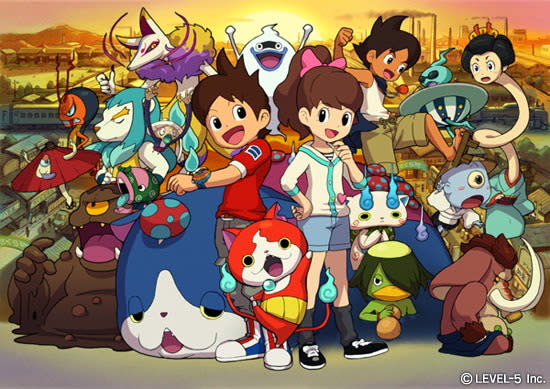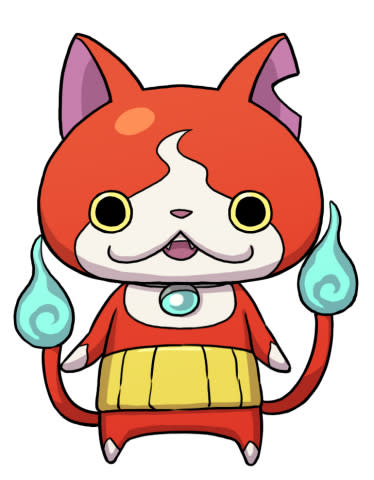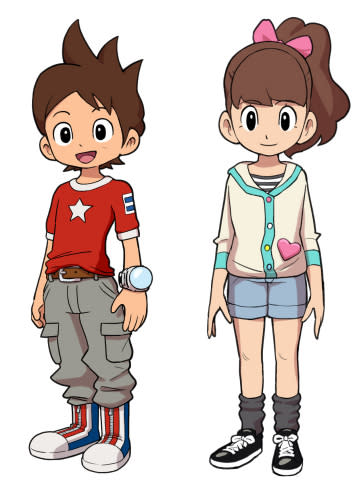Why Yo-kai Watch is crucial for Nintendo’s future

Gaming execs: Join 180 select leaders from King, Glu, Rovio, Unity, Facebook, and more at GamesBeat Summit. This is an invite-only event so apply now!
Get used to that two-tailed orange cat (just look above), because you’re going to be seeing a lot of it come next year.
Yo-kai Watch is Japanese studio Level-5’s answer to Pokémon. Just like Nintendo and Game Freak’s mega-franchise (which has sold over 245 million games to date), Yokai Watch’s main audience is children, and it features monsters and collection-based gameplay. The franchise also launched with a cross-media approach — just like Pokémon — with graphic novels and a television animation series. While it doesn’t have the decades of history that Pokémon has (the first game was only released in 2013), Yokai Watch is already a cultural phenomenon in Japan. The 3DS games alone have sold over 7 million copies in Japan, and the greater franchise has made over $1 billion at retail on toys and related merchandise — and that’s not counting publishing or music.
The plan for its move West has already been set.
In 2016, Nintendo will publish the first Yo-kai Watch 3DS game in North America, with Europe, Latin America, Australia, and New Zealand following soon after. American toy company Hasbro announced last month that it will bring a new Yo-kai Watch toyline to the U.S. next year as well. And while an announcement on the television-animation series is still pending, Japanese-American entertainment company Viz Media announced that it will publish the series’ graphic novels in North America starting this year. This two-year coordinated ramp up closely matches that of Pokemon’s rise in the 1990s. If the involved parties approach this launch properly, Yo-Kai Watch has a good chance to be the next big Japanese import for children in the West.
Above: Jibanyan is one of the first friends you meet in Yo-kai Watch.
Image Credit: Nintendo
Pokémon improved
The Yo-kai Watch story follows a young boy named Keita (Nate in the West) out on a bug hunt in the countryside with friends. He stumbles across an old capsule toy machine stuck in the base of a mysterious tree. Inside one of the capsules awaits a spirit named Whisper. Upon being freed, Whisper grants the boy a magical watch — the Yo-kai Watch — that can reveal a hidden world of spirits and creatures. These creatures are mischievous, invisible forces behind most of the world’s unexplained problems, sort of like hauntings by unseen pranksters. With this newfound power, the group (they meet and befriend Jibanyan soon after) sets out to explore this hidden world and help those affected by these invisible problem spirits.
The game is squarely is aimed at young children, but it has a slightly different approach than Pokémon does — one that Japanese parents liked. Its tone is not unlike Level-5’s own Ni no Kuni, an award-winning 2013 PlayStation 3 release that focuses on storytelling and friendships over battling. In Yo-kai Watch, the creatures the duo finds with the watch are more funny or silly than scary, and the goal of just about every interaction is to befriend — not capture — these creatures. If a friendship is successfully initiated, these creatures grant the protagonist a special medal that they can insert into the watch to summon them at any time. Yo-kai Watch does have a monster-collecting and battle element tied to this summoning system, but it’s less about winning tournaments (Pokémon) and more about helping those in need. The result is a simplified, kinder Pokemon.
This family-friendly approach was initially appreciated by players and the Japanese games media following the July 2013 release of the first 3DS game, but it wasn’t until the 2014 release of the animated television series that sales really took off for the Yo-kai Watch. The animation proved to be a better showcase for the series’ strong characters and storytelling than the game, and it wasn’t long before Japanese children were hooked. Young fan demand had the 3DS game disappearing from store shelves and suddenly topping Japanese sales charts.
Above: Keita and Fumi, the main heroes of Yo-kai Watch. They’ve been renamed for the West to Nate and Katie.
Image Credit: Nintendo
Widespread success
It has been uphill from there ever since. Early 2014 brought about the release of the second Yo-kai Watch game for 3DS, which was split into two slightly different editions, much like the Pokémon releases of recent years. It even managed to outsell last year’s Pokémon remakes, Omega Ruby and Alpha Sapphire, in Japan. And the upgraded late-year rerelease of Yo-Kai Watch 2 sold 2 million copies in December alone. The arcade game, which is compatible with physical medals from the Yo-kai toyline, continues to draw lines of children eager to dump 100 yen coins into the machine (which also carries a child-friendly height and design). Level-5 isn’t stopping here: Just last week, the third numbered game in the series was announced as well as five other franchise titles, including one partnership with Japanese game publisher Koei Tecmo and three going to mobile.
Pokémon owes much of its success to a multitiered marketing approach, and Yo-kai Watch emulates that model with its own games, toys, and animation projects And it’s working: The hit animated television series has a second season in the works, and the first animated film managed to be the highest grossing opening weekend of any Japanese film since 2000, topping even Disney’s Big Hero 6 in Japan.
That marketing muscle continues to flex in other fields, too. The Yo-kai Watch graphic novel series, which won two prestigious publishing awards, continues its popularity, and more print projects are in the works. The toyline, including the hard-to-find version of the Yo-kai Watch itself, continues to sell out as soon as it comes available at Japanese retail. There are even fast food and theme park marketing deals in place — a ride called Yokai Watch: The Real debuts at one Japanese park this year. There’s even a popular exercise calisthenics dance that children love to do, based on a part of the television show. All the kids know it — check YouTube.
Japanese roots
Yo-kai Watch was designed to resonate with Japanese children specifically, so it the localization team will face many challenges leading up to the Western release. The creatures of the series’ world are based on characters straight out of Japanese folklore. These beings — literally youkai — take a number of shapes and forms, like frog-like river creatures or long-haired female spirits. These won’t mean anything to Western children, but Japanese kids are familiar with these mythical creatures and are able fully appreciate the silly, pun-based naming scheme that series’ creators went with. And it’s not just the lore that is Japan-specific: The locations, relationships, and nonplayer characters are all just as unabashedly Japanese. The localization teams for all related properties have their work cut out for them.
It seems that some of the changes in messaging are already being shaped. In the announcement press release for the Western release of Yo-kai Watch, Nintendo notes that these creatures are not ghosts. “Yo-kai: They are not ghosts, monsters or creatures. Yo-kai are, quite simply, Yo-kai, it says.” But some of them technically are, or at least their source characters from Japanese folklore are. As an example, in the first story, the initial yo-kai Keita meets is a cat that haunts an intersection where he died. That’s the twin-tailed orange cat, Jibanyan.
“Some people argue that Youkai (Japanese ghosts) are part of Japanese folklore and that this might make it hard for the game series to establish itself in the West,” analyst and consultant Dr. Serkan Toto told GamesBeat.
“On the other side, Pokemon is largely “culture-free” and thus easier able to travel across countries. There is some truth to this argument, but I think the “Japan factor” in You-Kai Watch is relatively weak. Nintendo should be able to adjust certain elements of the game to a Western audience if needed.”
Toto continues: “In the end, the quality of the games matter, and this is where You-Kai Watch shines. I think You-Kai Watch will also be successful across media in the West.”
Missing key for success
It’s not that the games industry needed another Pokémon. The franchise is still one of Nintendo’s most important — firm License Globals says it makes $1.5 billion yearly. But Level-5 got a taste of how nice a carefully constructed cross-media IP can be to its bottom line with soccer-based franchise Inazuma Eleven. It too saw a structured game-and-anime launch, with a toyline and marketing blasts following. Now it’s going all-in on its own simplified, friendlier Pokémon, and it’s delivering the heart of the franchise — the game — on Nintendo’s own platform.
Despite the franchise’s Japan-centric story and setting, Level-5 had an international release in mind from the beginning. As early as last year, company CEO and franchise creator Akihiro Hino teased that Level-5 was already in talks with a Western toy manufacturer that said its upcoming partnership would “absolutely succeed” in the West. That company turned out to be Hasbro, which now hints at further broadcast, gaming, and merchandising relationships for the property.
It’s clear that there’s potential for enormous success for Yo-kai Watch in the West, but one of the key ingredients of the formula is still missing: the animation. The Pokémon cartoons helped grow a cult following in the West long before the first game released. Through it, the varied personalities of the now famous cute monsters were on full display, pushing the door wide open for new fans. The animation would go on to be a massive success for Western distributor 4Kids, and that success continued through the release of the first several games. Nintendo eventually took over distribution of Pokémon’s video properties in the West. The series has since seen almost two dozen films and television specials, and the television franchise has seen its 17 seasons broadcast worldwide.
As of now, Westerners have no legal way to view Yo-kai Watch. Fans subsist on unofficial localizations downloaded from the Internet, and this will likely continue until an official Western distributor is named. There have been a number of favorable changes since the 1990s for Japanese animation in the West, and now any one of the number of anime-dedicated streaming services such as Crunchyroll or Viz could end up being the official home to the Yo-Kai Watch anime. It’s just that someone has to lock down that deal — and then contend with the massive localization-and-dubbing chore.
What lies ahead
Nintendo, as publisher of the first game, arguably has the easiest job of the companies involved in Yo-kai Watch’s Westward move, but it still faces a challenge. Level-5 is a well-respected developer, known for the Professor Layton franchise among others, and gamers know to expect a quality game. But it’s going to have to work to show children why they should pick it over Pokémon, let alone other popular children’s game properties such as Skylanders and Disney Infinity. Marketing and messaging are going to be key — Nintendo and all of the other parties of the cross-media effort are going to have to nail that.
While Yo-Kai Watch isn’t Nintendo’s own property, having a piece of the publishing business could be huge for the company. Aside from Yo-Kai Watch, Level-5’s own Inazuma Eleven and Professor Layton have been very successful for it and Nintendo as 3DS releases — the former reached global sales of 6.5 million units. From the Japanese performance, Nintendo is fully aware of Yo-Kai Watch’s worldwide potential. If it gets even close to Pokémon’s level on a worldwide scale, Nintendo’s publishing division and its 3DS will benefit greatly.
With the potential gains that lies ahead, Level-5 will also need to do everything it can to ensure a nice landing for Yo-Kai Watch in the West. There’s still plenty that can be done to widen the approach, too. Locking down publishers for the new mobile titles would be among the top priorities if it hasn’t already. Japanese mobile publisher DeNA would be a prime candidate for both its strength in branded games and its new relationship with Nintendo.
If Pokémon’s continued worldwide success is any indication, all of this work should pay off for all companies involved. The Japanese figures of $1 billion plus in merchandise sales and 7 million games sold should serve as sufficient motivation. Keep your eye on Yo-kai Watch this next year.



